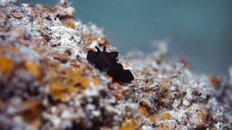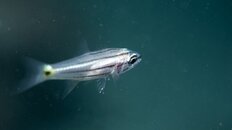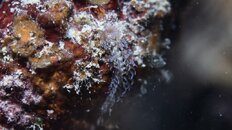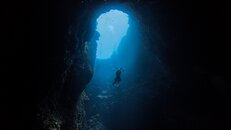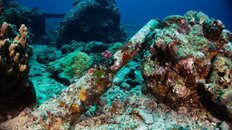poolisopen
Registered
Two years ago, during my first liveaboard trip to the Sea of Cortez, a group of fellow Californian divers shared stories about their favorite diving experience: a trip aboard the Palau Siren. Since then, it has been at the top of my bucket list. This year, we finally decided to take the plunge and book a week-long trip for April 2025.
The Journey to Palau
The trip to Palau is long and exhausting, involving a four-segment flight. From AUS-LAX-NRT-GUM-KOR, it took us a grueling 28 hours to finally reach our destination. We arrived in Koror at around 1 AM on March 31st, where we stayed at the Palau Central Hotel for two nights before boarding the renowned Master Palau Siren.
A Scenic Bonus: Smile Air Flight
One unique non-diving experience we had was a flight with Smile Air. The B course (a 40-minute scenic flight) costs around $200 USD per person but was absolutely worth it. The flight gave us stunning aerial views of the rock islands, Blue Corner, German Channel, and other dive sites, offering a fantastic preview of what lay ahead.
Boarding the Palau Siren
On April 1st, we were greeted by the friendly Siren crew, who took us to the boat. It turned out the boat was mostly booked by an Australian dive shop, with only my wife and I as the solo travelers. The atmosphere was warm and welcoming, and the vibe was great right from the start.
The Palau Siren is an Indonesian wooden sailboat that accommodates 16 guests. While it isn’t as luxurious as the Scubaspa liveaboard we experienced in the Maldives, the cabins are cozy, and I was pleasantly surprised by the spaciousness of the diving deck and camera tables. The boat uses two skiffs to transport divers to dive sites.
Diving with the Palau Siren Crew
Our group was divided into three smaller dive groups (6+6+4), and we were fortunate enough to be placed in the “camera group” with just four divers. The crew was incredibly helpful, carrying our gear to and from the skiffs, making everything effortless for us.
Day 1: A Taste of Palau's Diving
On April 2nd, we started our diving adventure in the Oolong area, anchoring there for the day. Our first dive was at Sandbar, which was a gentle checkout dive with a sandy bottom and no current. The second dive took us to Siaes Corner, a nice wall dive. Although the guide had warned us about a potential strong current and the need for a reef hook, we encountered only mild currents and enjoyed a relaxing swim. Our final dive of the day was at Oolong, a beautiful drift dive where we saw several blacktip sharks and unique lettuce corals. Unfortunately, it was getting dark, and I wasn't able to capture the corals in the best lighting.
Day 2: More Diving and Relaxing
The next morning, we dove Oolong again, and this time, the current was more favorable. We had great views of sharks, but the outgoing tide meant we missed the lettuce corals. Later, we moved to Two Dogs area for a dive at Siaes Channel, which was deeper (max depth 105 ft) and featured a coral cavern. Afterward, we enjoyed another drift dive along the wall. For the final dive, we had the option of either German Channel or the New Drop-Off. Given the tide conditions, we opted for the New Drop-Off, which turned out to be a fantastic reef-hook dive with shark sightings. We also spotted a leopard shark, which was a real highlight. Throughout these dives, the guides were excellent, and we never once had to fight the current, which made for a much more relaxed experience compared to other liveaboards I’ve done. One big plus about Palau is the lack of overcrowding at the dive sites—most of the time, we had the sites to ourselves, making the experience feel more intimate. And let’s not forget the food—absolutely outstanding.
Day 3: Blue Corner and Blue Hole
The third day started on a high note when we spotted a manta doing barrel rolls off the side of the boat while enjoying my morning coffee. We completed four dives that day: Blue Corner, Blue Hole, Turtle Cove, and a night reef dive. At Blue Corner, we encountered some outgoing current, which required a bit of effort to stay near the wall. Blue Hole was my favorite dive of the trip so far—beginning with a swim through a blue hole, we entered a sea cavern, followed by a drift dive along the wall, and finished with an exhilarating incoming current hook dive to watch shark action. The safety stop was a treat as a giant school of jacks surrounded us. Turtle Cove was a more relaxed wall dive, where we saw numerous turtles. Although Palau isn’t particularly known for macro photography, I was able to capture some great shots on my first attempt at macro diving.
Day 4: Diving and Relaxation
On our fourth day, we started with a dive at German Channel, hoping to catch some manta rays at the cleaning station. Unfortunately, no manta sightings, but the dive was still enjoyable. The second dive was at Virgin Blue Hole, which offered beautiful swim-throughs and a relaxing ambiance. For our final dive, we returned to the New Drop-Off—another stellar dive. The crew surprised us with a beach dinner under a starry sky. Tomorrow, we would head to Peleliu.
Day 5: Peleliu—History Meets Diving
Peleliu, located at the southernmost tip of Palau, is known for its strong currents and unpredictable tides. It’s about a 30-minute boat ride for liveaboards, but over an hour for land-based dive shops. Our first dive was at the Cut, where we swam to Peleliu Express. Despite the strong current reputation, the day was surprisingly mild, and we had a great time. Our second dive took us to Orange Beach, a stunning coral garden with historical artifacts from World War II, including battle tanks, bullets, anchors, and rocket launchers.
Unfortunately, the day wasn’t without some hiccups. The boat nearly hit one of our diver at descend, and on our return journey from Peleliu, we struck a wood log, which damaged the engine, forcing us to wait for rescue. The crew handled the situation professionally, acknowledging the issues and letting the captain go the same day. They even rented another skiff for the next day's diving. For the third dive, my wife and I chose to take a much needed rest and skip the dive at Blue Corner.
Day 6: Wrapping Up with Memorable Dives
On our last day of diving, we have the outgoing tide again which meant poor visibility to dive at Oolong. Instead, we had a fantastic dive at Siaes Corner with crystal-clear visibility and abundant marine life. The only minor annoyance was we ran into a large dive group from Black Pearl. Their dive masters led the group into the blue (instead of staying within the atoll) to chase sharks, which scared away all the fish. The second dive was at Iro Wreck, a beautiful wreck with great swim-throughs. To end the trip, we dove the Chandelier Cave, a pristine cavern system that reminded me much of the cenotes in Yucatán, with gorgeous stalactites and three air chambers for divers to surface and admire the ceilings.
Conclusion: A Truly Unforgettable Experience
That concludes our liveaboard trip with Palau Siren. It was undoubtedly the best liveaboard—or perhaps the best recreational diving experience—I’ve had. The crew was exceptional, and we made lasting friendships along the way. In fact, we’re already planning a Philippines Siren liveaboard trip to Tubattaha in 2027. The Palau Siren has set a new standard for diving experiences, and I can’t wait for the next adventure.
The Journey to Palau
The trip to Palau is long and exhausting, involving a four-segment flight. From AUS-LAX-NRT-GUM-KOR, it took us a grueling 28 hours to finally reach our destination. We arrived in Koror at around 1 AM on March 31st, where we stayed at the Palau Central Hotel for two nights before boarding the renowned Master Palau Siren.
A Scenic Bonus: Smile Air Flight
One unique non-diving experience we had was a flight with Smile Air. The B course (a 40-minute scenic flight) costs around $200 USD per person but was absolutely worth it. The flight gave us stunning aerial views of the rock islands, Blue Corner, German Channel, and other dive sites, offering a fantastic preview of what lay ahead.
Boarding the Palau Siren
On April 1st, we were greeted by the friendly Siren crew, who took us to the boat. It turned out the boat was mostly booked by an Australian dive shop, with only my wife and I as the solo travelers. The atmosphere was warm and welcoming, and the vibe was great right from the start.
The Palau Siren is an Indonesian wooden sailboat that accommodates 16 guests. While it isn’t as luxurious as the Scubaspa liveaboard we experienced in the Maldives, the cabins are cozy, and I was pleasantly surprised by the spaciousness of the diving deck and camera tables. The boat uses two skiffs to transport divers to dive sites.
Diving with the Palau Siren Crew
Our group was divided into three smaller dive groups (6+6+4), and we were fortunate enough to be placed in the “camera group” with just four divers. The crew was incredibly helpful, carrying our gear to and from the skiffs, making everything effortless for us.
Day 1: A Taste of Palau's Diving
On April 2nd, we started our diving adventure in the Oolong area, anchoring there for the day. Our first dive was at Sandbar, which was a gentle checkout dive with a sandy bottom and no current. The second dive took us to Siaes Corner, a nice wall dive. Although the guide had warned us about a potential strong current and the need for a reef hook, we encountered only mild currents and enjoyed a relaxing swim. Our final dive of the day was at Oolong, a beautiful drift dive where we saw several blacktip sharks and unique lettuce corals. Unfortunately, it was getting dark, and I wasn't able to capture the corals in the best lighting.
Day 2: More Diving and Relaxing
The next morning, we dove Oolong again, and this time, the current was more favorable. We had great views of sharks, but the outgoing tide meant we missed the lettuce corals. Later, we moved to Two Dogs area for a dive at Siaes Channel, which was deeper (max depth 105 ft) and featured a coral cavern. Afterward, we enjoyed another drift dive along the wall. For the final dive, we had the option of either German Channel or the New Drop-Off. Given the tide conditions, we opted for the New Drop-Off, which turned out to be a fantastic reef-hook dive with shark sightings. We also spotted a leopard shark, which was a real highlight. Throughout these dives, the guides were excellent, and we never once had to fight the current, which made for a much more relaxed experience compared to other liveaboards I’ve done. One big plus about Palau is the lack of overcrowding at the dive sites—most of the time, we had the sites to ourselves, making the experience feel more intimate. And let’s not forget the food—absolutely outstanding.
Day 3: Blue Corner and Blue Hole
The third day started on a high note when we spotted a manta doing barrel rolls off the side of the boat while enjoying my morning coffee. We completed four dives that day: Blue Corner, Blue Hole, Turtle Cove, and a night reef dive. At Blue Corner, we encountered some outgoing current, which required a bit of effort to stay near the wall. Blue Hole was my favorite dive of the trip so far—beginning with a swim through a blue hole, we entered a sea cavern, followed by a drift dive along the wall, and finished with an exhilarating incoming current hook dive to watch shark action. The safety stop was a treat as a giant school of jacks surrounded us. Turtle Cove was a more relaxed wall dive, where we saw numerous turtles. Although Palau isn’t particularly known for macro photography, I was able to capture some great shots on my first attempt at macro diving.
Day 4: Diving and Relaxation
On our fourth day, we started with a dive at German Channel, hoping to catch some manta rays at the cleaning station. Unfortunately, no manta sightings, but the dive was still enjoyable. The second dive was at Virgin Blue Hole, which offered beautiful swim-throughs and a relaxing ambiance. For our final dive, we returned to the New Drop-Off—another stellar dive. The crew surprised us with a beach dinner under a starry sky. Tomorrow, we would head to Peleliu.
Day 5: Peleliu—History Meets Diving
Peleliu, located at the southernmost tip of Palau, is known for its strong currents and unpredictable tides. It’s about a 30-minute boat ride for liveaboards, but over an hour for land-based dive shops. Our first dive was at the Cut, where we swam to Peleliu Express. Despite the strong current reputation, the day was surprisingly mild, and we had a great time. Our second dive took us to Orange Beach, a stunning coral garden with historical artifacts from World War II, including battle tanks, bullets, anchors, and rocket launchers.
Unfortunately, the day wasn’t without some hiccups. The boat nearly hit one of our diver at descend, and on our return journey from Peleliu, we struck a wood log, which damaged the engine, forcing us to wait for rescue. The crew handled the situation professionally, acknowledging the issues and letting the captain go the same day. They even rented another skiff for the next day's diving. For the third dive, my wife and I chose to take a much needed rest and skip the dive at Blue Corner.
Day 6: Wrapping Up with Memorable Dives
On our last day of diving, we have the outgoing tide again which meant poor visibility to dive at Oolong. Instead, we had a fantastic dive at Siaes Corner with crystal-clear visibility and abundant marine life. The only minor annoyance was we ran into a large dive group from Black Pearl. Their dive masters led the group into the blue (instead of staying within the atoll) to chase sharks, which scared away all the fish. The second dive was at Iro Wreck, a beautiful wreck with great swim-throughs. To end the trip, we dove the Chandelier Cave, a pristine cavern system that reminded me much of the cenotes in Yucatán, with gorgeous stalactites and three air chambers for divers to surface and admire the ceilings.
Conclusion: A Truly Unforgettable Experience
That concludes our liveaboard trip with Palau Siren. It was undoubtedly the best liveaboard—or perhaps the best recreational diving experience—I’ve had. The crew was exceptional, and we made lasting friendships along the way. In fact, we’re already planning a Philippines Siren liveaboard trip to Tubattaha in 2027. The Palau Siren has set a new standard for diving experiences, and I can’t wait for the next adventure.



